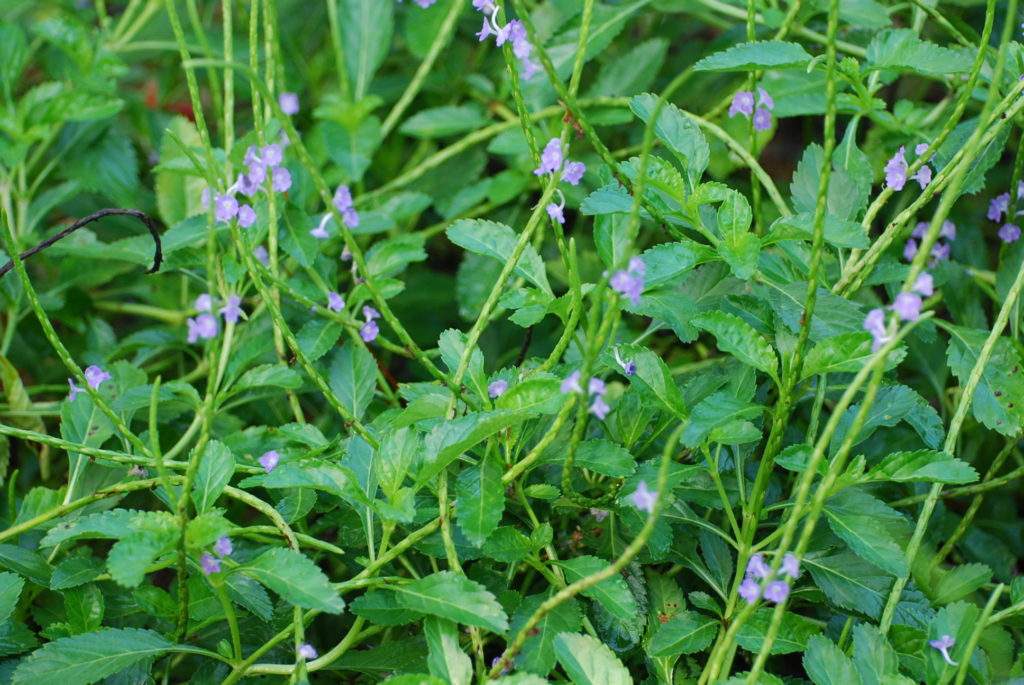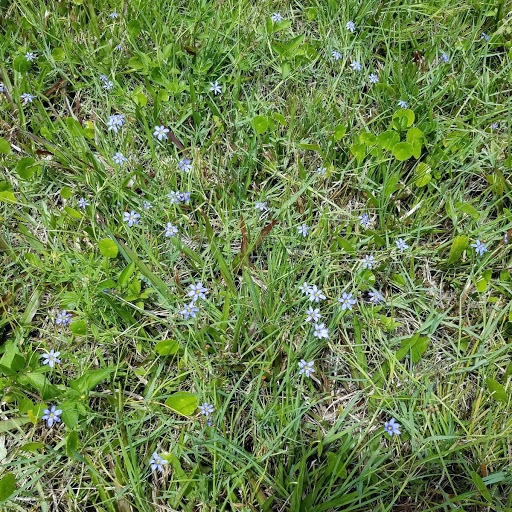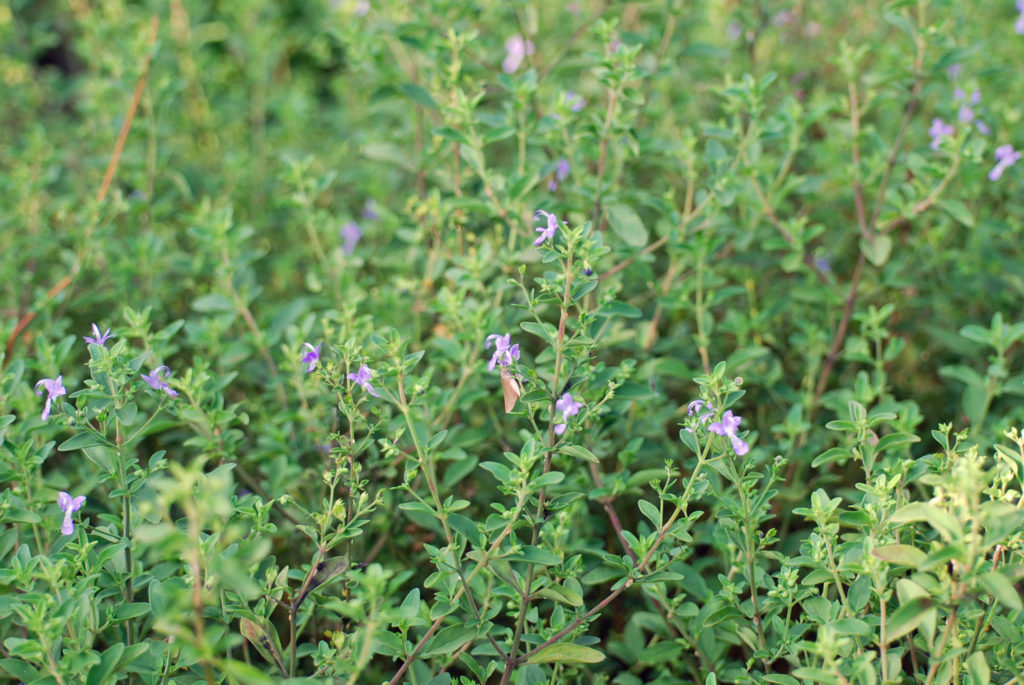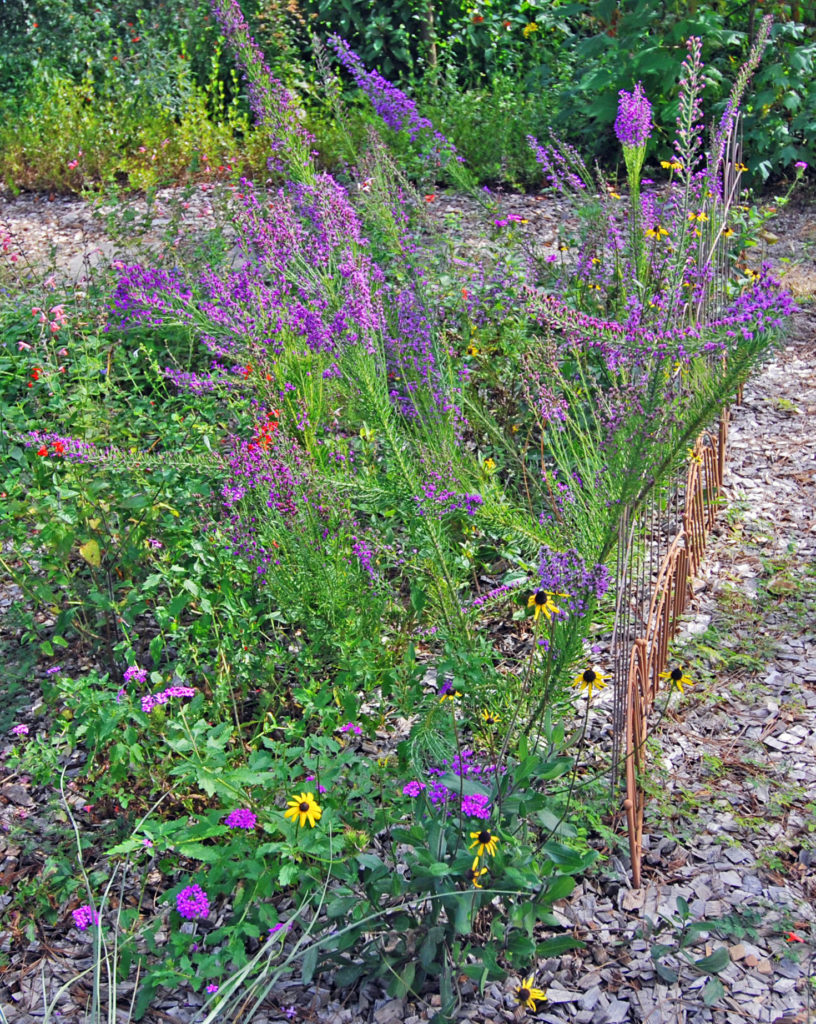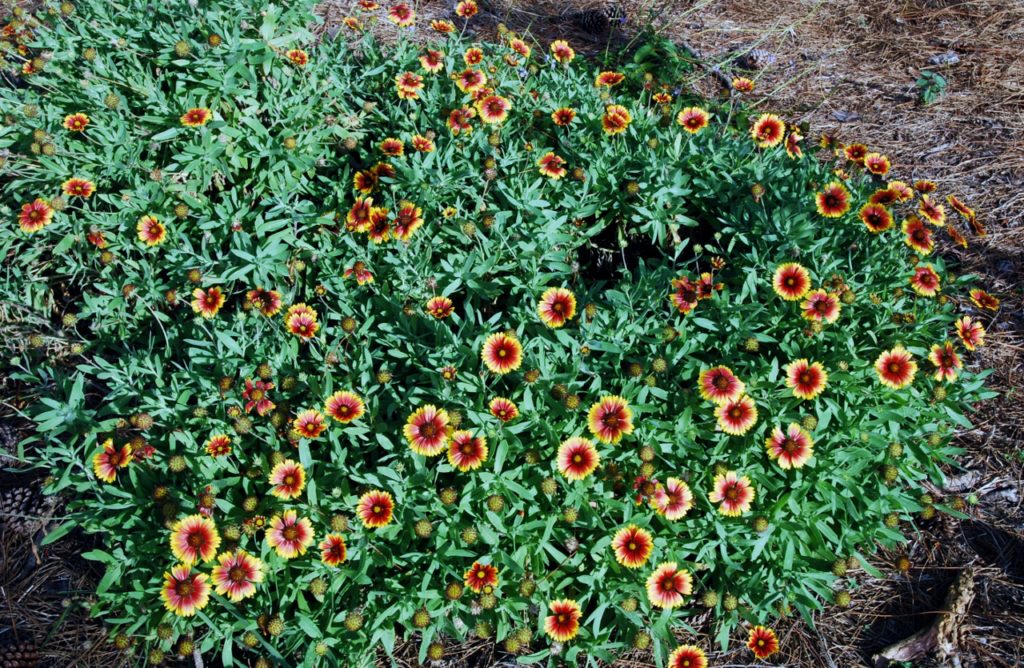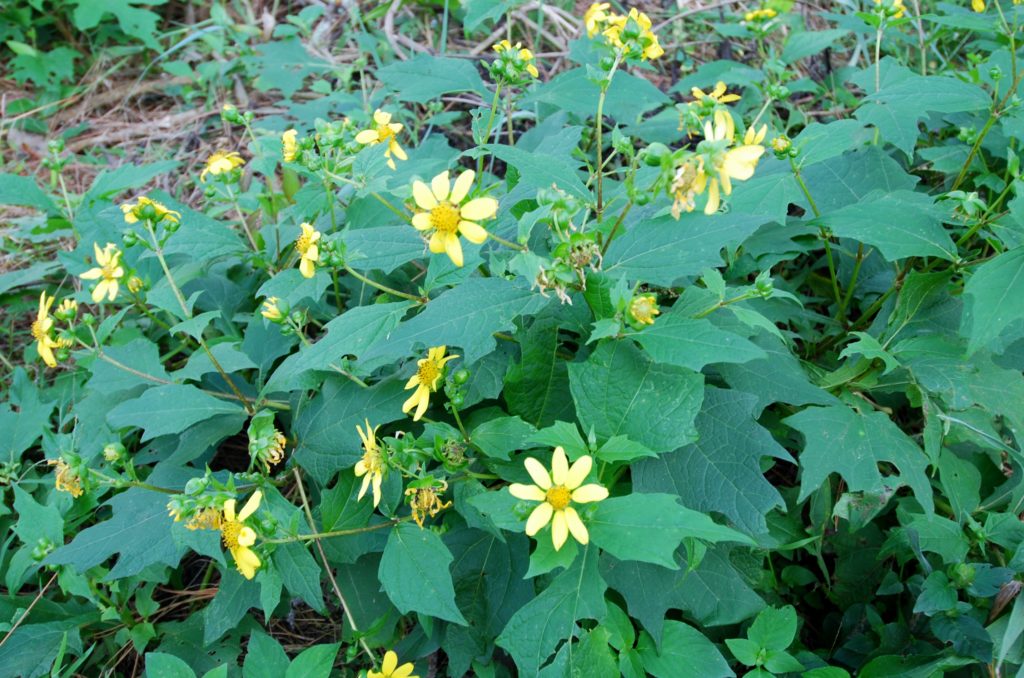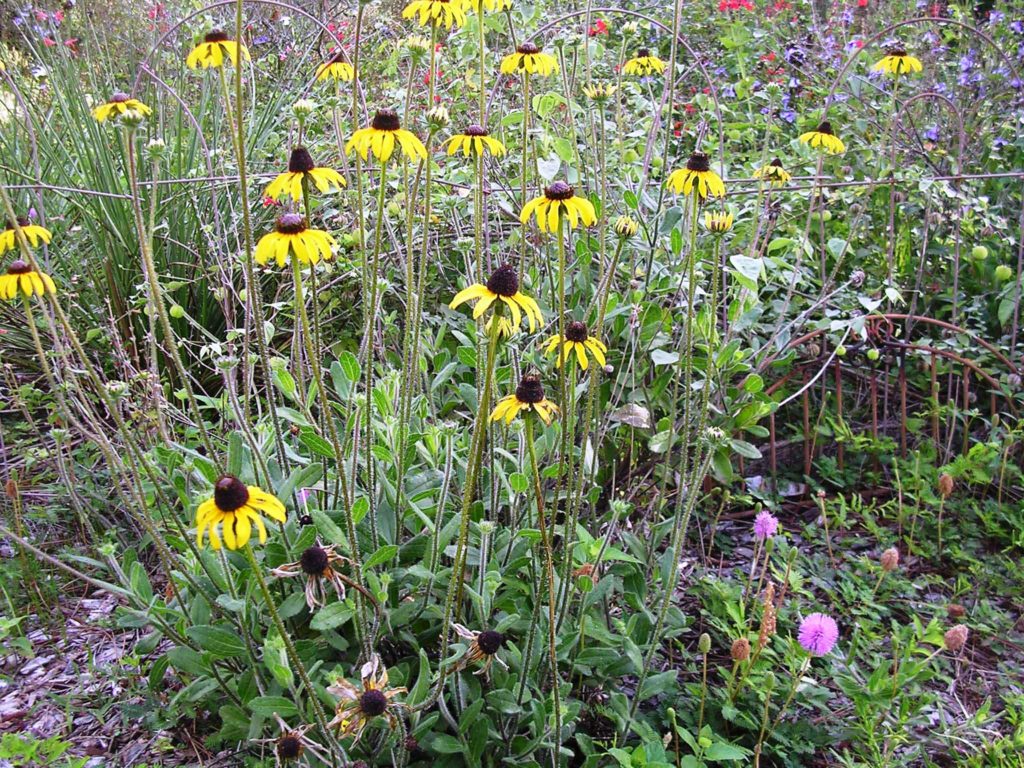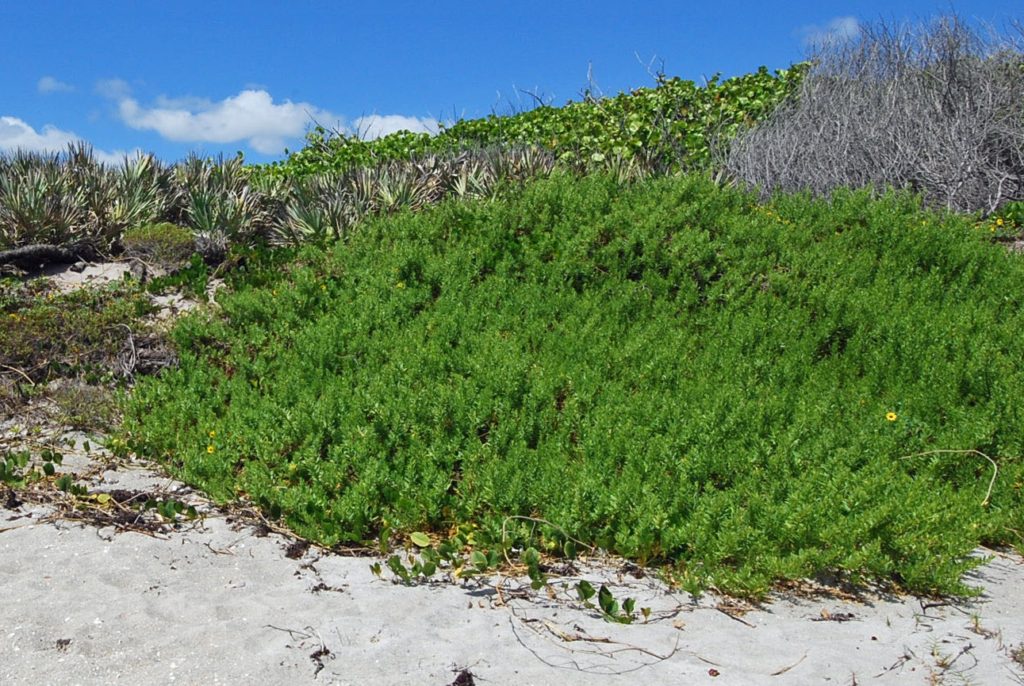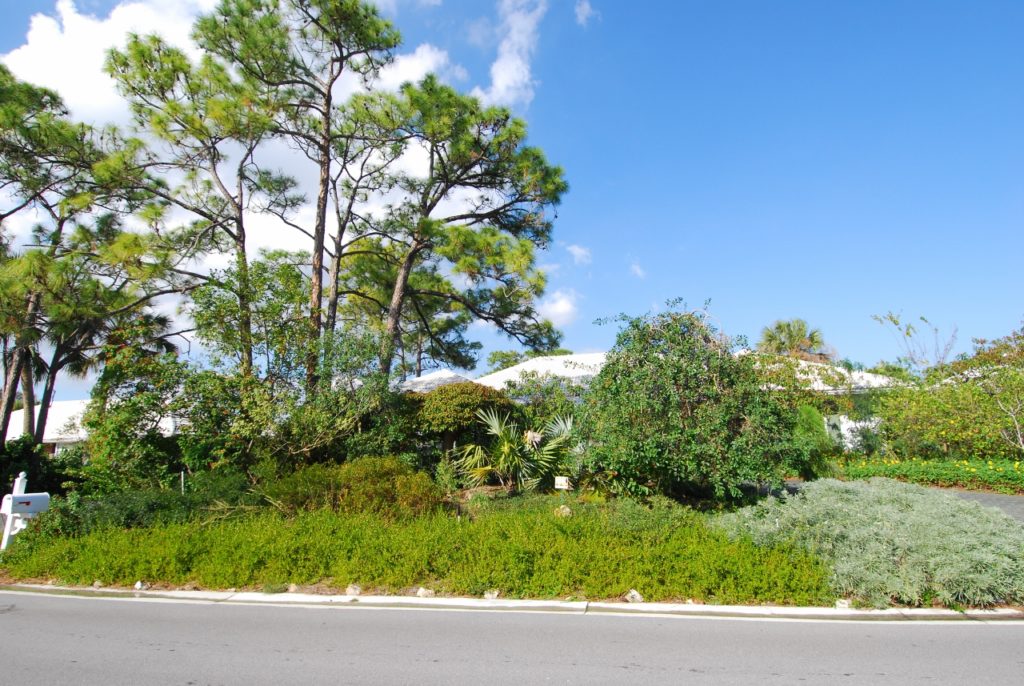Blue Porterweed
Stachytarpheta jamaicensis
Blue Porterweed is found in the Rocklands of the Everglades to Key West in open, sunny places. The leaves are three inches long and a bit leathery and smooth. It has a low, mat forming growth usually under 18 inches tall.
The small blue flowers are born on a whip like spike and are very attractive to butterflies. The larva of the Tropical Buckeye Butterfly feeds on the leaves.
The exotic Nettleleaf Vervain is up to six feet tall. Its leaves have a more quilted look and may be a bit hairy. It is invasive and is almost always sold as the native species. It should not be planted. Click here for more info.
Blue Porterweed prefers dry to moist soil and is surprisingly tolerant of short term fresh water flooding. It tolerates some salt air in back of other coastal shrubs.
This makes a nice edge along a butterfly garden where it will live for years unless there is a freeze. Usually it comes back from stubs or seedlings. You may want to keep it just a bit back from where its ranginess can be noted easily.
The stems are hollowed by a moth caterpillar during the winter. Because of this, the plant should be cut back to a few inches and the stems thrown away. In March, when the weather warms, new growth will fill out the planting and fresh flowers will form until late fall.
In the Florida Keys native Porterweed is found along the coast behind Sea Lavender, Chapman’s Cassia, Beach Elder, Sea Oxeye Daisy, Salt Meadow Cordgrass, Blackbead, Black Torch, Bay Cedar and Silver Palm.
You can mix this plant with your favorite wildflowers and enjoy the many butterflies that it attracts.
For more information click here.
Blue Eyed Grass
Sisyrinchium angustifolium
Blue Eyed Grass or Narrowleaf Blueeyed-Grass can be found from the Florida Keys through eastern Canada and west to Texas. It is in the Iris family and has half inch wide blue flowers with a yellow center.
Beware of the Annual Blue Eyed Grass which is native to South America and can spread throughout your yard. Click here for more info.
It needs fresh water, full sun and constantly moist soil to survive. Plants are in clumps that may be inches to a foot or more wide. They are usually below 12 inches tall.
When found in the wild it is often mixed with Tick Seed, Pineland Petunia, Pineland Pinklet, Largeflower Rosegentian (Marsh Pink), Silkgrass, Florida Lily and Creeping Charlie.
In the garden you can combine it with the above and Prairie Iris, Yellow Canna, American Crinum Lily, Browne’s Savory, Glade Lobelia, Marsh Fern, Little Blue Stem and other wetland species.
I have seen wet medians that were covered with Narrowleaf Blueeyed Grass in bloom. The dark blue flowers made an eye catching display. Too bad they only bloom in the spring and not all year long.
So instead of dumping fill to level the low wet areas of your yard, try planting with Blue Eyed Grass and other wetland species to create a wonderful wet prairie. Cypress, Pondapple, Buttonbush, Red Maple and Sweetbay Magnolia trees make a nice background on the north side.
For more info click here, and here.
Blue Curls
Trichostema dichotomum
Blue Curles is an annual wildflower with soft bluish green leaves and a rounded form. It is found along the back dune and scrub habitat. It is very drought tolerant in poor soils once established. Salt air is tolerated along with small amounts of salt water.
The small, half inch blue flowers are numerous and are attractive in a mass. Song birds eat the numerous seeds along with the insects attracted to them. Bees come to the flowers, yet not butterflies.
Use this in a mix of wildflowers that reseed themselves. Try Red Salvia, Southern Beebalm, Wild Basil, Beach Verbena, Silk Grass, Spiderwort and Dicliptera for a mix that provides seeds for birds and flowers for butterflies.
This planting will change as the seedlings come up in different places from year to year. Just rub the seeds off of the dry seedheads onto some areas free of mulch to start next years planting. You may need to rub the soil lightly to mix in the seeds.
Although the flowers aren’t large, there are enough of them to provide color to the planting. With a long blooming period from early summer to fall and lovely bluish leaves, Blue Curls has earned a place in our gardens.
For more info on this plant click here, and here.
Blazing Star
Liatris gracilis
Graceful Blazing Star, Liatris gracilis is our most adaptable species for home use. This is found nearly throughout Florida and is also known as Slender Gayfeather. This is a real treat to come across during a walk in the woods in late summer and fall.
It is usually found in pine flatwoods and can tolerate short periods of flooding. A slight amount of moisture in the soil is best for this Blazing Star, although irrigation is not usually needed.
The spikes of purple blooms shoot up to two or more feet tall in the fall and last for several weeks. It will die back to the enlarged root and disappear for the winter. Look for grassy foliage in the spring and mulch around it.
Try mixing with Mimosa, Beach Verbena, Blackeye Susan, Salvia, Love Grass, Coreopsis species, Rattlesnake Master, Wild Petunia, Twinflower, Lopsided Indian Grass, Silky Aster and Florida Spiderlily.
Although this is my favorite species of Blazing Star, there are others that might do better in extreme sites. These include Dense Blazing Star, Liatris spicata, which grows in wet prairies. This is often found in the marl prairies of Everglades National Park. The long rubbery grass like leaves make a nice border and the flowers are spectacular.
This species blooms in the late summer and fall. It mixes well with Silkgrass, Pityopsis graminifolia, which has yellow blooms at the same time and is under 12 inches tall. Try the same mix as with Graceful Blazing Star. Unfortunately, Dense Blazing Star does not come back in the spring on my property. Maybe you can be more successful.
Shortleaf Blazingstar, Liatris tenuifolia, is the third species that I have grown. It naturally grows in dry pinelands and scrub throughout Florida. It, too, tends to die out after blooming in late summer, yet is still beautiful enough to use as an annual. If your soil is naturally dry, such as near and east of I95, you may find this a good choice.
For more information about Graceful Blazing Star click here, and Dense Blazing Star click here. And finally Shortleaf Blazingstar click here.
Did I mention that all the Blazing Stars are favorites of bees and other pollinators?
Blanketflower
Gaillardia pulchella
Blanket flower or Indian blanket is a coastal plant that is found growing in interdune swales from Melbourne, Florida north to Virginia. It is very drought and salt tolerant and reseeds itself for years. You can find this wildflower growing just a few feet back from the loose sand on the beach.
The 2.5 inch wide flowers are on 18 inch tall stalks that may continue flowering for almost a year, or at least three months. It will get an anthracnose fungus disease if wet. The result is mushy leaves. This is also a prairie plant and is found in the Western United States.
Mix Blanketflower with other beach plants like Dune Sunflower, Salvia, Beach Verbena, Southern Beebalm, Sea Oats, Blue Curls, Key Lily, Sea Lavender, Bay Cedar, Golden Creeper, Partridge Pea, Beach Bean, Cakile, Beach Elder, Beach Cocoplum and Sunshine Mimosa.
I have planted this in dry areas of my yard and had it come back from seed for over five years. You can easily add it to other areas by picking the gray seed buttons and rubbing the seeds loose wherever you want them. Wear gloves for this.
There may be a few flowerless months during the winter when the old plants die back and the new seedlings take over.
It is now believed by many plant experts that gaillardia is not native to Florida. There are records of it being found along our beaches in the 1700’s though. Even if it isn’t native to Florida, I think that it offers enough to our birds, bees, butterflies and other pollinators to have a place in our gardens. Click here, and here.
For more info click here, and click here.
Bear’s Foot
Polymnia uvedalia
Bear’s Foot grows from New York to Central Florida and west to Texas. It is found along the edge of forests and can range from two feet to six feet in height. The leaves are normally eight to 12 inches long with deep lobes and short hairs. It is not irritating.
I have found this plant as far south as Merritt Island near Cocoa Beach. It was on the edge of the road in dry sandy soil with hammock trees providing part shade. In our yard it grows well in deep shade and full sun. It does not tolerate standing water for long and will wilt within a couple of days when flooded.
The flowers are yellow and are attractive to both butterflies and bees. We had one bumblebee for a few days on a plant in the spring of 2018. This was the first time we had seen a bumblebee in South Florida for almost ten years.
The oval seeds are lentil size. They are produced under the ray flowers and not the disc flowers as in Sunflowers. It seems that birds and other creatures spread these seeds to new areas of the yard where they are often welcomed by us.
Personally, I like to grow this perennial spreading wildflower under tall trees like oaks and pines. It can be cut back to six inches once or twice a year if you want to keep it lower. In South Florida it has leaves and flowers year round.
A nice mix for the shade includes Bear’s Foot, Native Ferns, Grasses, Wild Coffee, Marlberry, Beauty Berry, White Crownbeard, Ironweed, Saw Palmetto and other shade tolerant plants. In full sun, anything goes, but remember that it needs some room to spread out.
For more info, click here, and click here.
Black Eyed Susan
Rudbeckia hirta
The three inch wide yellow flowers of this 18 inch tall clumping wildflower are seen throughout the summer across the U.S. Although most of the flowers have a brown center, some plants have flowers with yellow centers. These must be propagated from cuttings in order to keep this trait.
Black Eyed Susan is found along roadsides and other areas with rich, moist soil. It is thought that this plant has spread to new sites by hitching a ride in “honey apples.” I have found it to be more abundant in areas near horse trails.
The Three inch narrow leaves of Black Eyed Susan have short stiff hairs on them. They are not irritating. The flowering of individual plants lasts for nine months or more in the garden and they often reseed in rich soil. If the soil dries out too much though, the plant will recede.
Although this is often used as a butterfly nectar plant, the seeds are food for Goldfinches as they migrate north in the spring. Sometimes we have a “fallout” during the spring migration. This is when high winds force migrating birds to take a break until things ease up a bit.
Nothing like having Golf Finches, Indigo Buntings, Cedar Waxwings and other species flying about the yard for a few days or weeks. We have a feeder with white millet in it for the Painted Buntings and one year dozens of Goldfinches dropped during a “Fallout” and shared it with them.
Black Eyed Susan mixes well with Blue Eyed Grass, Prairie Iris, Spiderwort, Sunshine Mimosa, Coreopsis, Florida Lily, Tampa Verbena, Pineland Petunia and native grasses and ferns. This is one of the most popular wildflowers in America.
Please see these links for more information click here, and click here.
Beach Verbena
Glandularia maritima
Beach Verbena is native to our eastern coastline. I have only found it along the coast from Martin County north to St. Johns County. It likes a rich, yet dry soil with two inches of mulch, gravel, rocks or any dry material on the surface. It doesn’t like to lie on wet soil. Flooding, too much rain or even being too dry will kill this plant.
Beach Verbena lasts a year or two and does best in full sun and if kept a few feet from aggressive plants like Dune Sunflower. If crowded, it will grow upward as if chest bumping its opponent and may reach two feet in height. This creeping plant normally stays below six inches tall and may spread out three feet from the base.
The small rounded leaves are an inch wide and the purple flowers are in attractive clusters. This is a good plant to attract butterflies with and some of our seed eating birds. It unfortunately doesn’t come up from seed very often.
Try Beach Verbena in combination with Sunshine Mimosa, Dune Sunflower, Salvia, Monarda, Seaside Goldenrod, Coontie, Blue Curles, Spiderwort, or any other coastal plant. Just remember to give it and its neighbors room to spread. It is best to grow this plant from seed in a nursery. The older plants will gradually get viruses which are passed along with rooted cuttings.
For more info, click here.
Beach Elder
Iva imbricata
Beach Elder or Seacoast Marshelder grows along the coast from the Florida Keys to Virginia. The light green, succulent leaves are an inch long and the small, inconspicuous flowers have light purple petals. The wind pollinated flowers can cause hay fever, See this for more info, click here.
This is a plant that traps sand on the beach just out of reach of the tides. It will grow up on the dune too and makes a nice mix with Sea Oats, Salt Meadow Cordgrass, Seashore Dropseed, Sea Purslane, Sea Lavender, Bitter Panicum, Dune Sunflower and other coastal plants.
If you would like a beach theme on your property, make sure you have full sun and dry, loose soil. If there is room, try a backdrop of Blue Sawpalmetto and mix together the coastal plants that you like.
Beach Elder may grow to four feet tall and more wide and provides cover for wildlife and seeds for birds and native beach mice if you are on the coast. See this article for more info click here. You may need to give this plant extra fertilizer to get it up to a decent size. Once established, it needs no additional care unless you want to trim it to a lower height.
See this for more info, click here.
Beach Creeper
Ernodea littoralis
Beach Creeper is a low growing, drought tolerant plant that forms mounds of gold. For dry sites in full sun this is one of my favorite long term ground covers. The golden plant on the left side of the picture is Beach Creeper and the silver plant on the right side is Sea Lavender. There is no lawn on this property.
The narrow succulent leaves are up to 1.5 inches long. The one inch tubular flowers are white to pink and not very showy, yet the clusters of lentil sized, golden round berries are attractive. The stems are weak and bend over forming a mat that can be left at its natural 2-3 foot height or cut back to one foot each spring.
This is an endangered plant found in the Florida Keys and along the coast to Volusia County. I like to use it to seal off a planting along a road or driveway. Plant it back from the road a good three feet so that it can be cut back to within one foot of the plant and not need trimming again for several months.
Beach Creeper can be planted on the west side of our East Coast dunes or anywhere inland with well drained soil and full sun. It mixes well with Bay Cedar, Beach Cocoplum, Sea Lavender, Key Lily, Coontie, Cactus, Seaside Joyweed and wildflowers. Just give it some room from its neighbors. I see no information saying that the berries are poisonous or edible. They are attractive to birds though.
Here is some more information on this wonderful plant. Click here.
